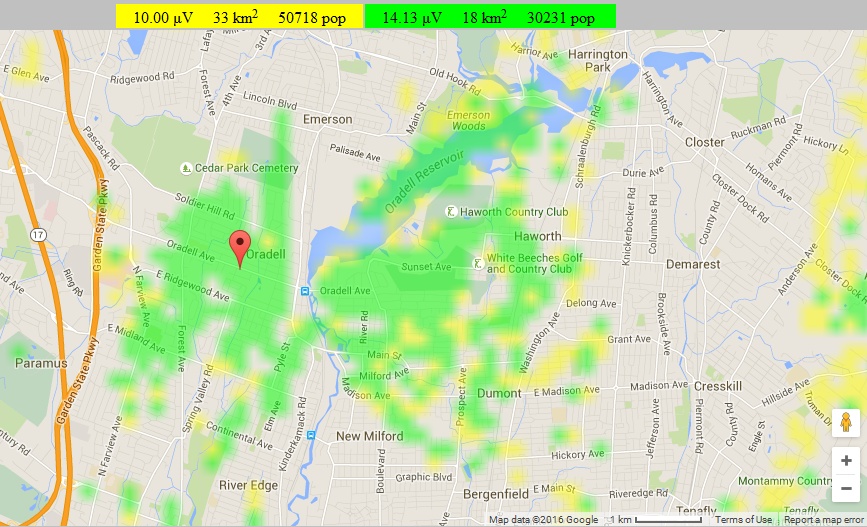Moved this antenna out of the attic to the outside of my QTH. Should get me better propagation and range.

I got it at last year's BARA hamfest, think it's a 12dB gain omnidirectional wifi antenna. Have it hooked up to my AREDN mesh node Linksys router. Also using a 1W wifi amp and preamp. Used some ethernet thicknet coax for the feedline (it's just good quality RG8U). It's mounted as close to the roof peak as I could get, as a garage below limits the reach of my ladder.
The web page that creates propagation maps: directions at http://n4njj.com/quick-easy-and-free-rf-projection-maps/ another web page that can create RF coverage maps of your QTH's antenna http://www.ve2dbe.com/rmonline.html
What it predicts for my 2.4GHz antenna and system:

I don't know how accurate, even to an order of magnitude...
73s
You are here
Outdoor commercial wifi antenna, propagation prediction web site
Sat, 04/30/2016 - 15:30
#1
Outdoor commercial wifi antenna, propagation prediction web site
Theme by Danetsoft and Danang Probo Sayekti inspired by Maksimer


Many of those amplifiers have been found to not be able to handle their full power without distorting the signal meaning you actually end up with a worse signal then what you would have without the amplifier.
I do recommend the radio mobile link (though I often use the desktop version myself) it can be very accurate when fed the right information.
Dual Polarity omnis will perform much better then a single polarity (especially vertically polarized) but are unfortunately much more expensive.
Are you running at channel -2 to avoid some part 15 noise since your likely vertically polarized ?
I have a 2nd node elsewhere in the house, with a small antenna and thus weak reception. Today it's wet weather and the wet roof should introduce more attenuation between the nodes. Thus I'm not likely overloading the 2nd node's front end. It typically sees the main node (the one with the amp) at "Signal/Noise/Ratio -66 / -90 / 24 dB"
 Though that SW did seem to make sense for a 2m prediction I ran.
Though that SW did seem to make sense for a 2m prediction I ran.

Looking at the 2nd node's averaged signal ratio (on the signal page) I played with different power levels of the main node (the one with the amp). I found what looks like a small sweet spot at 17dBm for its Tx power. Which would indicate that I might have been overloading the amp a little at higher settings (18 and 19), so I set it to 17. Hopefully I'll be a better neighbor now.
I did find the predicted coverage hard to believe, too.
..."AREDN mesh node Linksys router" is, but it sounds like a Linksys running BBHN software
Duh, that's what I meant to say
AREDN is for mesh networks!
i love it!
Seriously though, that amplifier is likely causing a ton of spurious emissions, so you won't be making any friends using it.
But welcome to the group! I am a big proponent of using Radio Mobile. If you set the variables right, it can be darn accurate.
Andre, K6AH
I did a run for my location and - comparing with actual known results - the computer results are wildly optimistic in certain directions. Even though I had checked the 'use land cover' option, it is plain to see that it is not adequately considering the effect of trees.
For leafy trees - if you are going right through the tree - the attenuation is on the order of 1-2 dB/meter of tree at 2.4 GHz. Going in a heavily-forested direction, from the transmitter, after 50-100 meters you are pretty much finished. Without (or above) the trees, on the other hand, the same signal will go 50 Km.
This brings up a good point, the mapping depends where you are at.
Most used source for Radio Mobile is SRTM, that was done by mapping from the space shuttle in 2000, over 16 years ago. Trees grow a lot in 16 years. Also buildings, I had one site I modeled as no coverage, only to realize SRTM was taken several years before the 10 story building was built and as such I had to model higher.
Also note with SRTM that some times the detected ground level is actually the canopy height of the trees in thickly forested areas (it's possible for the purpose of SRTM data) to be "below ground level" if in doubt I model my antenna at just above ground level for safety unless I'm sure I can verify my actual altitude.
Radio Mobile modeling is an art form as much as it is a science. Some times it takes a person to look and verify. That said I've had times (on 2m) where "no, the signal will not make it there it's not going to happen the software is absolutely wrong" only to find out the software was right, there was a 3 foot square where the antenna had to be and it had to match the description you put in to the letter, a foot higher or lower and you lost it.
Equally I had another case where SRTM data helped predicte a 2.4Ghz mesh node would work at 10 miles perfectly, and it did, when the wind was blowing at 20MPH. A tree 100 feet from the remote end and down a hill had grown some number of feet in 15 years so that signal only made it when the wind blew the branches out of the path.
Loss thru foliage is not new news. It goes back decades and is why paths were literally walked in the day. Of course, that is when a site cost $10s of thousands and such things as theodolites were commonly used. Now that a microwave transceiver cost a couple of hundred dollars any expense seems silly (especially if it is a personal budget). However, a drive along the path noting the height of everything on the path (especially near the ends) isn't as silly. Long ago, I had a path that shot thru a coal mine slag pile. Initially it wasn't there, but ... The point is, a drive along is worth while and with today's gps (APRS?) is not as big of a deal.
Computer models (Radio Mobile) for path modeling are as good as the data that is available and this thread is the only place I have seen that describes the loss thru trees. As described, is quite variable. LOS + 0.6 Fresnel might seem excessive for a path in ham radio, but if someone is pretending to offer emcom I would give it some serious consideration. Otherwise it is just something for 2 hams to mess with and cannot expect anything reliable.
Not to be pissy ... it is Xerox
-Jeff W9NIZ
My generals plan for "loss through trees" is to assume it's 100% absolute and nothing makes it through so it's why I don't bring it up much more then to say must have line of sight. If a tree blocks the view I no longer have line of sight and as such I just assume it won't work for purposes of link planning for anything I'm scooping out to be a production link (I plan very pessimistically for emcomm )
it is a bit of a different thought process 2m is much more forgiving then 2.4GHz (Microwave) and yes we do sometimes try and make make it a bit more simplistic in simplification of describing it but your spot on on your points of keeping clearance for reliability and driving the path to make sure.
I have driven a lot of miles without getting out of my chair by using Google maps where you drag the little yellow guy onto any road that is highlighted in blue. By the time I actually go somewhere to look I am quite familiar with all the local landmarks. Another thing you must do is take whatever point-to-point path you have found and follow along it with the Google earth images. its amazing how many times a really nice path will hit a water tower, or tall apartment building, square-on. Our record here is to spear three water towers with one path.
That is the elephant in the room, isn't it?
Earlier this year I read a story about a guy who flew a small plane (ultra-light?) all over the US. I think think he took in the entire lower 48. They asked him what was his main impression from the voyage. He answered that he had not appreciated, until his flight, that 1/3rd of the US - the entire area east of the Mississippi from Maine to Florida was basically one big forest. I guess after flying over the plains states, deserts and Rocky Mountains the contrast was dramatic.
Outside of metro areas having tall buildings, I think many fixed microwave networks in the Eastern part of the US are going to be hilltop locations hitting other hilltops and a few people down below, who manage to get a view of one hilltop between their trees. These users certainly cannot hear each other. This topography is more suited to an access-point / station configuration than a mesh. So I am concerned about the plans to drop that configuration as part of AREDN (in fact, it does not work in the current release).
What is needed, more than fancy software, is a neighbor-friendly, low visibility, skyhook that can support one or two small microwave antennas at 60-100 ft AGL, with minimal fuss and cost. Now THAT would be something.
I am at the top of a hill, but there's lots of trees around me. Only direction with less trees is towards Armstrong's old Alpine NJ tower. I suppose if I did have the predicted range, I'd see, via the wifi scan, tons of wifi routers. I see about 10 such devices, one an Optimium hot spot. Which is located about 200 meters south of me.
"low visibility, skyhook that can support one or two small microwave antennas at 60-100 ft AGL"
Maybe a small box, like a small Ubiquiti, fed by a long ethernet cable (POE), mounted in a tall tree. With an antenna at the end of a short run of coax, that would poke above the tallest branches. This requires someone comfortable at climbing trees to install it, and the box reliable enough to take the weather with no attention. And with lightning protection of some sort.
Same small box atop existing tall ham towers would work too. Not a lot of those around though.
The NanoStation is fully self contained no external coax, the antenna is built in. Just run cat 5 to it and you are good to go. These are great when you want to go one direction.